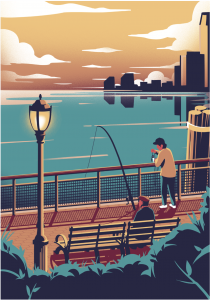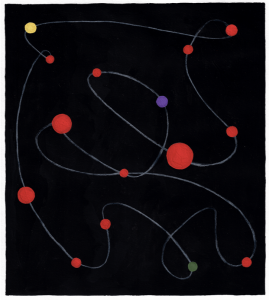New York may not seem the obvious place to indulge the pastoral pastime of fishing, but then it isn’t a city known for following the rules. Taken from Issue 20, our special issue on the city

The New York angler may be the most misunderstood outdoorsman of them all, because what could be more vile than someone who fishes in the dark polluted waters of New York?
Live here long enough and you’ll see us, perched along the East River, or in Sheepshead Bay, using shrimp or clam as bait, waiting for our hooks to set, and avoiding irritation from the city dwellers who inevitably stop to ask:
“You really go fishing in this water?”
“Do you eat what you catch?”
“Ever caught a body part?”
“Can I take your picture?”
My answer to #3 is No: although I have caught mattress chunks and human hair. But the questions are eye-roll inducing because we’re well aware that fishing in New York is not the same as casting for trout in the crystalline streams of a freshwater river. But like many aspects of New York, from sunbathing on its sooty beaches to playing catch in wilting parks, fishing is an exercise in compromise, and one with an idiosyncratic culture all of its own.
I started fishing around the city last summer when I moved to Chinatown and noticed a local angling community. Men pedalled around the neighbourhood on bikes equipped with fishing rods and tackle boxes, and they pedalled back home with plastic bags containing thrashing fish. The fish were caught from the East River – possibly the filthiest New York waterway of them all – where the men would post up with cigarettes and reel in striped bass, blackfish, bluefish, sea robins and writhing eels. I’d enjoyed fishing in the past, so I decided that with an open mind, I could give it a shot.
I bought my first rod from an aquarium supply store on Delancey Street that maintains a small bait and tackle operation behind its counter front. I got lucky with my first cast into the river. After reeling in the hard bite, the striped bass hit the concrete, instantly collecting street dirt. An old man rushed to my aid. A paper bag was produced and the fish slipped inside. I let him keep it. A local jab at Chinatown’s fish markets is that certain specimens probably come from the brackish waters just a few blocks away.
Some New Yorkers eat fish that comes from city waters. Bottom feeders like eel, sea robin and flounder are found all around New York Bay, and it probably isn’t wise to eat them, but it happens. On the other hand, one of the most prized eating fish in North America, the striped bass, is found in the same waters.
Stripers are prized for their fight and their taste, and they engage in an annual spring run up the Hudson River, considered one of the great migrations of the East Coast. It starts in Lower New York Bay, near the financial district, and makes its way up the Hudson, where it eventually concludes in the northern reaches of the state. At peak, the rush of fish is so intense that one can cast a hook just about anywhere and land a striper. From spring until late summer, a striper caught near the World Trade Center could be the same striper caught off flashy East Hampton, where it would be served for $50 with a squeeze of lemon. Try explaining this to a fellow New Yorker, however, and you’ll get concerned stares. (I don’t eat city fish, and practice catch-and-release.)
For all the indignities that city anglers endure, like crowds watching them reel in what ends up being a car tyre, there are moments that transcend the concrete.
The best-known fisherman in my neighbourhood may be a man I call Prescription Bottle Tony. He’s in his 80s, his name is Tony, and he uses a prescription bottle wrapped in monofilament line as a rod. A metal washer on the line serves as a weight, and clam is his bait of preference. On summer afternoons, I fished with him, and, as he jigged on the prescription bottle’s line, he told me what it was like fighting in the Korean War.
Another afternoon, seagulls started feasting on the waters just off Catherine Street. This is a good sign because it means a school of fish has arrived, which means large apex predators – like big striped bass – are lying nearby in wait. Practically everyone caught something that day, including an old Greek man who spoke no English and watched from afar with envy. Eventually, I invited him to join me and we traded casts for over an hour without exchanging a word. Later, we reeled in a plump striped bass as the sun started to set.
Battery Park, at the foot of Manhattan, has one of the most popular fishing sites in the city, because its waters are closest to the Atlantic. This boulevard of park benches is crowded with boom boxes playing Cuban jazz and men chomping cigars. One afternoon, I sat on the moorings and dangled my legs over the water. I held my rod loosely, lost in the vast expanse of ocean ahead of me. After a while, it was easy to forget a metropolis was behind me at all. I caught nothing that afternoon, but it didn’t bother me.
Inevitably, you become an advocate for the maligned hobby, and you find that the stereotypes of fishing still ring true in New York. Even below skyscrapers, fishermen stretch yarns about the size of their fish, they swear by lucky lures, and they guard locations of fishing holes closely. I didn’t think I’d adopt any of these clichés, but I picked up all of them, including an urban fishing hole of my own.
As the season started to wind down, my friend Sam and I went to Staten Island. We took the ferry from Manhattan, armed with our rods, and visited Liedy’s on arriving, which is the oldest bar on the island. I asked the owner if he had any suggestions on where to fish. He divulged we should try the waters behind a lonely gas station two miles down the road.
It was a scene of dilapidation. Old warped train tracks ran behind the gas station, and past them, a pebble beach littered with trash. The Manhattan skyline loomed quiet and small in the distance. We followed the warped track until we encountered a rocky chasm. A concrete structure stood in the waters and a creaky plank led to it.
We crossed carefully and then made ourselves at home, setting up sandwiches and beers. A group of striped bass fed right below us. We spent an hour trying to game them with our bait. Large oil tankers rolled past and a full moon started to glow. After a while, it became bright and huge. I stopped caring about the fish, and started casting out over and over again as far as I could, just for the joy of it.




